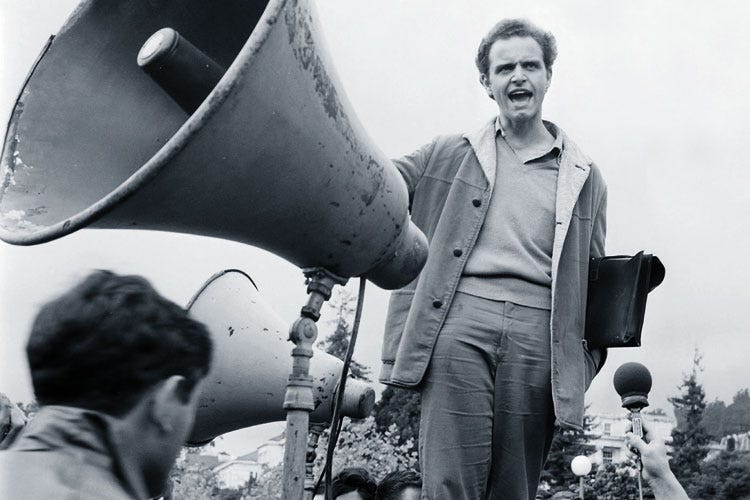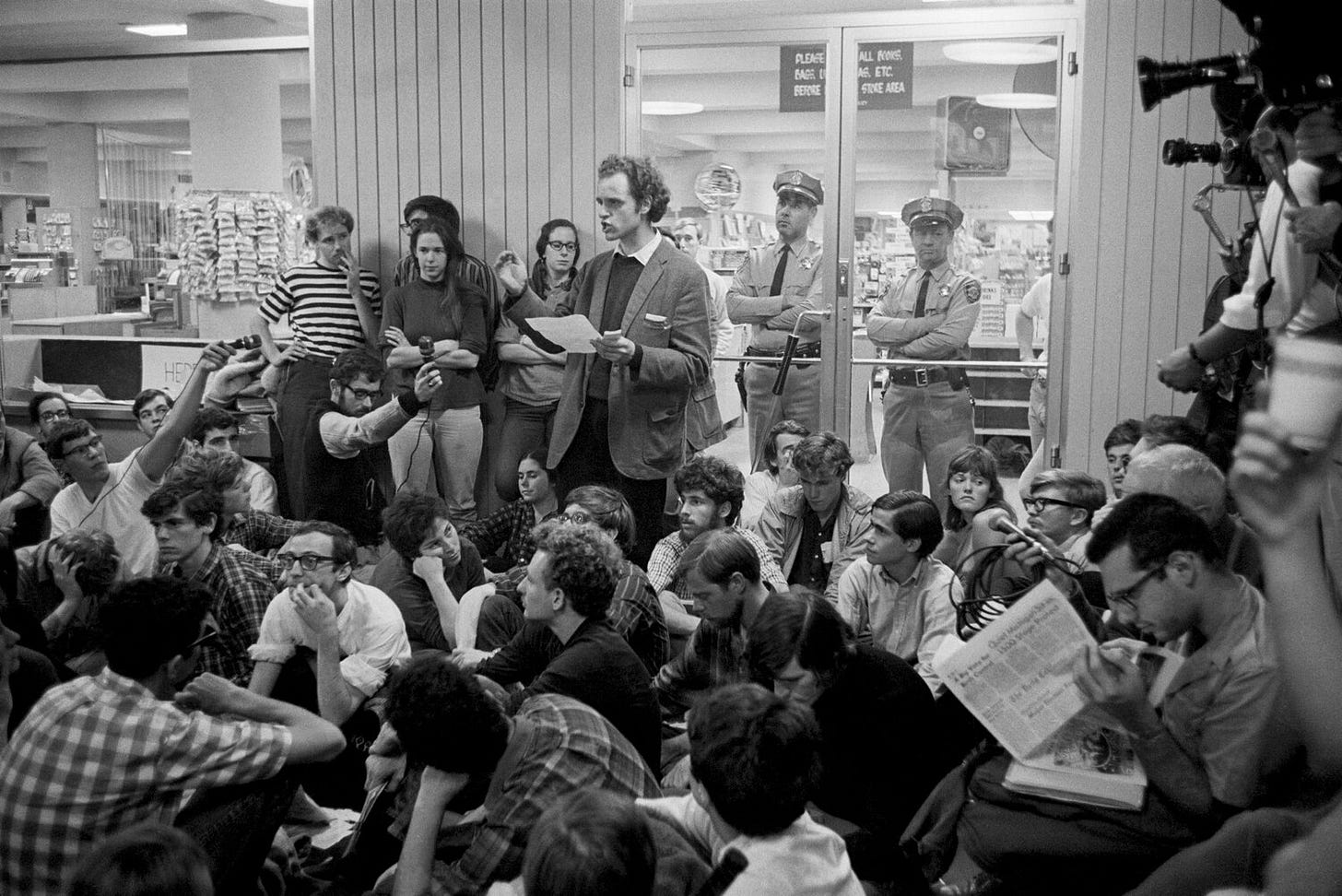On December 2, 1964, founder of the Free Speech Movement, Mario Savio, gave one of the greatest impromptu speeches of all time, against a public university (in this case Berkeley):
There’s a time when the operation of the machine becomes so odious, makes you so sick at heart that you can’t take part! You can't even passively take part! And you've got to put your bodies upon the gears and upon the wheels, upon the levers, upon all the apparatus — and you’ve got to make it stop! And you've got to indicate to the people who run it, to the people who own it — that unless you’re free the machine will be prevented from working at all!!
While Berkeley and the Free Speech movement are usually caught up in the broader conversation about campus protest and the Vietnam War, Savio’s ire was directed at the University as a machine, against the President, the Regents, the deans, and the entire leadership apparatus turning education into a factory, with faculty as labor and students as raw material being turned into finished “products.” Savio distrusted university leadership, with good reason, as I have written :
At Berkeley, Savio had been let down by the dean of students and the “dean of men” who led the disciplinary action against him. These deans expelled him, testified against him, and told him not to return. I remain startled by the institutional short-sightedness in betraying this young man whose free-speech principles transcended partisanship.
Why was the administration angry with him? They were angry because he was sick of the mass-produced slop the university was requiring. Or as he put it, pointing up at Sproul Hall:
we'll do something which hasn’t occurred at this University in a good long time! We're going to have real classes up there! They’re gonna be freedom schools conducted up there! We’re going to have classes on [the] 1st and 14th amendments!! We’re gonna spend our time learning about the things this University is afraid that we know! We’re going to learn about freedom up there, and we’re going to learn by doing!!
And now, 60 years later, we are in an era of mass-produced, required gen ed classes not only in the California system but across the country, and there are no Mario Savios (yet) complaining.
What is today’s machine? A system of “seamless transfer” that is growing across the country, where soon every state-required class at every public university will have the equivalent of a QR code that will make it recognizable to every other public university and you can stack these classes toward an “education,” or at least a credential. Who is teaching these classes? It does not matter to the machine.
In CA, your first two years of college (taken in a community college, at a CSU or UC) is literally branded “the singular general-education pathway,” even if the costs are wildly different. You can pay ~$1,400 in annual tuition at the community college, ~$6,000 at a CSU, or ~$14,000 at a UC for credits that satisfy exactly the same statutory requirement. (Horizontal-equity alarms should be going off. I’ll be writing more about this.)
The education machine has already dealt a mortal blow to Sonoma State, where Mario Savio was teaching at the end of his life, after the Cal State University system demanded that Sonoma start offering the same standard-issue courses:
What CSU could not, or would not, envision was a model where Sonoma’s uniqueness might be preserved while expanding access across demographics. But we live in a world where uniqueness matters less than a policy of standardization claiming it is advancing diversity.
The lessons extend beyond California. As public higher-education systems push for seamless transfer protocols, standardized learning outcomes, and uniform curricular requirements, the homogenized landscape — the institutional monoculture — will collapse.
I was a dean (at Sonoma State) when I first wrote about Mario Savio and I have since stepped down from leadership. It seems impossible to be a university leader and not be part of the machine, as I wrote recently in Inside Higher Ed, “The Higher Ed Nomenklatura,” alluding to the Soviet nomenklatura system — both a category of people approved by the Communist Party as well as the list of important government posts. With this system, only Party could get you appointed to the post. So you better get cozy with the party and start spouting “the party line”:
You can tell membership in the higher education nomenklatura by a vocabulary that is half statistics and half social justice. The goal is a system accessible to all, where every student gets a full menu of affinity and mental health resources yet also graduates (or gets credentialed) efficiently and there’s data to prove it. You hear phrases like “evidence-based,” “innovative transformation” and “strategies for fostering equity.”
Yet this administrative language obscures the fundamental question of educational substance. Sure it all sounds really great (who doesn’t like accessibility and counseling?) but the question is: what are the classes you are taking? Are they good classes? The qualifications of the faculty member and the experience of the faculty member no longer matter. Is this what you want to be paying for? None of the members of the higher ed nomenklatura are in the classroom.
This is all part of the broader problem in higher ed that I’ve written about for the past two months, not on Substack, so I will share here: How Business Metrics Broke the University:
Rapid enrollment growth accelerated centralization, especially at large public universities. As institutions enrolled tens of thousands of students in hundreds of programs across multiple campuses and online, leaders argued that the only way to ensure quality was with central oversight, with automated assessment systems and standardized practices. New administrative structures were born: “Institutional Effectiveness” offices launched to gather and report data, along with “Student Success” initiatives to track and improve retention metrics. New jobs like “Assessment Coordinator” were filled by staff without PhDs, to ensure every course had measurable “learning outcomes.” Data became the driving force behind academic decisions. Faculty were required to redesign courses around standardized rubrics. Departments faced pressure to adjust grading practices to maintain desired retention rates. Programs were evaluated primarily on their ability to meet numerical targets, and the administration prioritized research that had measurable real-world “impact.”
Does this seem machine like to you? It does to me. My larger point in that piece was about the political polarization that occurs when the bureaucratic gears are moving (as they did in Mario Savio’s day). Nobody likes working in a factory that pretends it is not a factory.
Universities must recognize that their experiment with centralized planning has had unintended consequences that have damaged the institution’s status and pose serious political risks. They must support their own faculty voices and devolve power to departments, not in deference to quaint traditions but as an essential mechanism for maintaining academic standards and intellectual diversity. Only by addressing the vacuum that enabled polarization can we universities claim their proper role as centers of reasoned debate and scholarly inquiry
This thinking led me back to James C Scott’s description of the logical failure of monoculture, high modernism, and Leninist ideals, in Seeing Like a State University. The operations of public higher ed these days demand unwavering enforcement a metrics and measurement paradigm; adherence to the party line creates a climate where political conformity is prized and heterodoxy is chilled.
Is it a coincidence that the decline of confidence in higher education has accompanied the rise in tools claiming to offer evidence of success? This misalignment between measurement and reality points to a fundamental question that centralized systems often overlook: what is higher education actually for? Again, while the State views universities primarily as economic engines that should produce graduates with specific career trajectories, this narrow focus misses the broader cultural, intellectual, and civic purposes that have historically defined higher education’s role in society.
How will it end? Nobody is happy with public higher education right now, even as all eyes are turned to Harvard. If I am optimistic, it is primarily about what AI could possibly offer. I have been telling faculty and students and everyone I come across to spend time with the better AI models and to understand what YOU know that it doesn’t know.
Every faculty member should begin to write a detailed memo specifying the following: “What specific knowledge do I possess that AGI does not? What unique insights or capabilities can I offer that exceed AGI systems? Which students, and in which topics, would benefit enough to pay to learn from me and why?” Faculty who cannot produce this memo with concrete, defensible answers have no place in the institution. There is no middle ground.
Every dean must immediately audit their course catalog against one criterion: what advanced knowledge or skills does this course offer that AGI cannot replicate? Each course must demonstrate specific knowledge transfer or skill development that exceeds AGI capabilities. It will become obvious that the highest value courses are those aligned with specific faculty expertise. General education courses focused on basic knowledge transfer become indefensible. If the information is general enough to be called “general education,” AGI can deliver it more effectively than any human instructor. This will eliminate most of the current curriculum.
Replacing current public higher ed factory with a new model under which faculty experts work with AI and educate the next generation in new ways must be the conversation ahead. Would Mario Savio would be on board? I think so:
The university is a vast public utility which turns out future workers in today's vineyard, the military-industrial complex. They’ve got to be processed in the most efficient way to see to it that they have the fewest dissenting opinions, that they have just those characteristics which are wholly incompatible with being an intellectual. This is a real internal psychological contradiction. People have to suppress the very questions which reading books raises.
Say what you will about AI, one’s engagement with it can be primarily intellectual, unlike the bureaucracy involved in public higher ed.
Maybe the choice is this: continuing to operate the educational machine that Savio recognized sixty years ago, now enhanced with digital surveillance and standardized metrics, or we embrace the creative destruction that AI offers. The universities that survive the next few years will be those that abandon the factory model entirely, empowering faculty to demonstrate their irreplaceable expertise while leveraging AI to eliminate the bureaucratic machinery that has devastated faculty morale. Only such a transformation will preserve the best part of the university and fulfill the promise of genuine intellectual freedom that Savio envisioned when he called for putting bodies upon the gears to make the machine stop.
.png)






